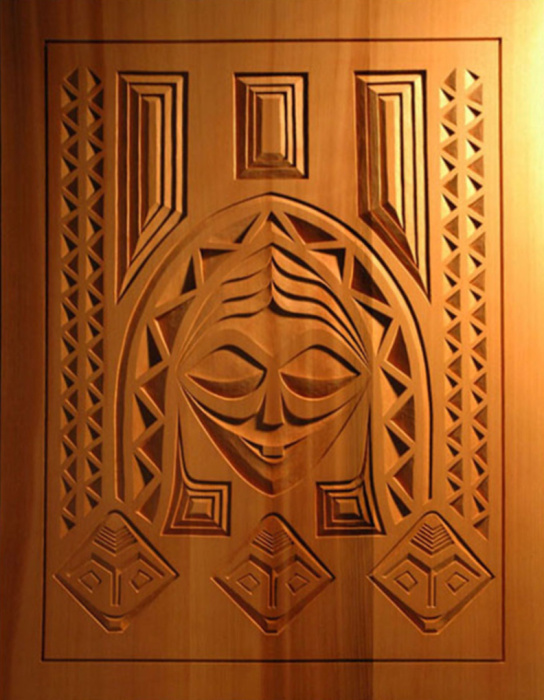“Adam McIsaac and I have worked side by side at the forefront of the revitalization of this highly important art for many years. His commitment to the high standards, and aesthetics of our ancestors has earned him a place of respect in our community. I thoroughly hope you love what you see here and that our art form brings you a stronger connection to this place and it’s indigenous people." —Tony A. (naschio) Johnson, Chairman, Chinook Indian Nation.
Columbia River basketry was among the finest ever produced along the West Coast. Cattail, bear grass and hazel brush was among the list of materials used. Artistic two-dimensional designs found on baskets play a role in the make up of this regions art style.
These beautiful works of art inspired Basketry Tamanawas. The center face represents the basket weaver. Along the bottom are humanoid faces in the form of diamonds. This is a common design found in Wasco basketry. Along the sides are triangles that form a zigzagging line. Across the top are concentric squares, both are common elements found in Columbia River art. This carving is an example of how similar carving and basketry are when considering the artistic designs applied.
During a Chinook’s life the quest for a spirit power plays a vital role. Males will search for this power their whole life, while women will stop searching at the time of menstruation.
This power board reflects the acquiring of one such power. The woman in the middle with long adorning earrings has acquired the spirit helper along the bottom. Carved humanoid faces in the shape of diamonds portray this supernatural being. Running along the sides are bands of triangles and concentric squares. The top reflects the trance like state one would inflict upon themselves in hopes to be visited by a spirit power.
I have spent the last 25 years of my life studying, teaching and producing artwork based on the indigenous peoples of the Columbia River. Historically Columbia River art was found along the river in many forms and mediums. The earliest of explorers recorded carved house posts adorning the exterior and interior of massive plank houses and large Cedar dug out canoes lining the riverbanks. Many people are unaware of this once prevalent existence. Inspired by the history and simplistic beauty of this art form, it has been my passion to bring Columbia River art back to local communities, and acknowledge it as the indigenous art of this area.
From an early age, Adam McIsaac has been rooted in the ways of the Pacific Northwest. The son of a fisheries biologist, Adam spent his formative years walking the forests and riverbanks of the Pacific Northwest absorbing the environmental riches abundant in this area. As Adam grew older, his connection to the Northwest manifested itself in a keen interest in the ways of northwest aboriginal cultures. Adam spent years studying and learning aboriginal life skills, passing this knowledge on as a teacher at well-known survival and aboriginal life classes throughout the Northwest. It is from this background that Adam’s passion for Northwest Coast Indian Art emerged.
Determined to refine his skills as an artist, Adam sought the guidance of world-renowned Northwest Coast artist, Duane Pasco. In an intensive understudy with Pasco, Adam’s artwork flourished, Adam gained considerable expertise in the art and culture of the Pacific Northwest and learned to make his own traditional tools that he used to create the centerpiece of his studies. Above all, Adam began what has proven to be a life long quest to understand and bring recognition to this unique form of art.
Over the last 20 years, Adam’s current focus has been on the art and culture of the Chinookan speaking peoples of the Columbia River valley, from the mouth of the Columbia River to the Dalles, Oregon. Inspired by their local artistry, Adam began his journey by incorporating Columbia River designs into traditional panels displayed at Skamania Lodge in Stevenson, WA and customary house posts standing at Blue Lake State Park in Oregon. Adam also played a large part in the Lewis and Clark Bicentennial for his ambitious role as head carver at the Cathlapotle Plank house in Ridgefield, WA. Through his goal in educating the people of this area in this indigenous art form Adam erected a ten-foot tall power figure as a mascot, The Navigator, at Columbia Valley Elementary School, he has carved panels for Portland State University, and placed carved woodland animals on the walls of Lake Stikney Elementary in Lynwood, WA. His love for the environment led to his contribution to the architectural splendor at the newly completed Port of Portland building that was named among the world’s greenest buildings.
Adam has also found much fulfillment in working with and learning from the local Natives. Many friendships have developed and Adam has had the honor to work with the Chinook, the Puyallup and the Confederated Tribes of Grand Ronde. This has been just yet another outlet where he can continue his goal in helping to revitalize the art of the Columbia River peoples. Adam’s artwork is respected and has become known as an integral part of local communities.
Adam’s true passion is to recreate accurately the artwork of the Northwest Coast as a means of bringing recognition to their culture and elaborate art form. All of Adam’s artwork adheres to the strict tribal standards seen in historical Northwest Coast Art and reflects its overall sophistication. Through this diligence, Adam brings the beauty and refinement of Northwest Coast art to all that seek it.
